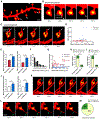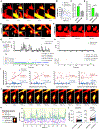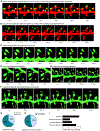Rapid 3D Enhanced Resolution Microscopy Reveals Diversity in Dendritic Spinule Dynamics, Regulation, and Function
- PMID: 32464088
- PMCID: PMC7879711
- DOI: 10.1016/j.neuron.2020.04.025
Rapid 3D Enhanced Resolution Microscopy Reveals Diversity in Dendritic Spinule Dynamics, Regulation, and Function
Abstract
Dendritic spinules are thin protrusions, formed by neuronal spines, not adequately resolved by diffraction-limited light microscopy, which has limited our understanding of their behavior. Here we performed rapid structured illumination microscopy and enhanced resolution confocal microscopy to study spatiotemporal spinule dynamics in cortical pyramidal neurons. Spinules recurred at the same locations on mushroom spine heads. Most were short-lived, dynamic, exploratory, and originated near simple PSDs, whereas a subset was long-lived, elongated, and associated with complex PSDs. These subtypes were differentially regulated by Ca2+ transients. Furthermore, the postsynaptic Rac1-GEF kalirin-7 regulated spinule formation, elongation, and recurrence. Long-lived spinules often contained PSD fragments, contacted distal presynaptic terminals, and formed secondary synapses. NMDAR activation increased spinule number, length, and contact with distal presynaptic elements. Spinule subsets, dynamics, and recurrence were validated in cortical neurons of acute brain slices. Thus, we identified unique properties, regulatory mechanisms, and functions of spinule subtypes, supporting roles in neuronal connectivity.
Keywords: calcium transients; dendritic spine dynamics; intrabodies; kalirin-7; live imaging; multi-synaptic spines; postsynaptic density; structured illumination microscopy; synaptic plasticity; synaptic spinules.
Copyright © 2020 Elsevier Inc. All rights reserved.
Conflict of interest statement
Declaration of Interests The authors declare no competing interests.
Figures








Similar articles
-
Dendritic spinule-mediated structural synaptic plasticity: Implications for development, aging, and psychiatric disease.Front Mol Neurosci. 2023 Jan 20;16:1059730. doi: 10.3389/fnmol.2023.1059730. eCollection 2023. Front Mol Neurosci. 2023. PMID: 36741924 Free PMC article. Review.
-
Protocol for live enhanced resolution confocal imaging of dendritic spinule dynamics in primary mouse cortical neuron culture.STAR Protoc. 2021 Apr 5;2(2):100427. doi: 10.1016/j.xpro.2021.100427. eCollection 2021 Jun 18. STAR Protoc. 2021. PMID: 33899014 Free PMC article.
-
Kalirin-7 controls activity-dependent structural and functional plasticity of dendritic spines.Neuron. 2007 Nov 21;56(4):640-56. doi: 10.1016/j.neuron.2007.10.005. Neuron. 2007. PMID: 18031682 Free PMC article.
-
Dendritic spinules in rat nigral neurons revealed by acetylcholinesterase immunocytochemistry and serial sections of the dendritic spine heads.Folia Histochem Cytobiol. 2004;42(2):77-81. Folia Histochem Cytobiol. 2004. PMID: 15253129
-
Spine Dynamics: Are They All the Same?Neuron. 2017 Sep 27;96(1):43-55. doi: 10.1016/j.neuron.2017.08.008. Neuron. 2017. PMID: 28957675 Free PMC article. Review.
Cited by
-
Distribution of spine classes shows intra-neuronal dendritic heterogeneity in mouse cortex.Neurophotonics. 2025 Jan;12(1):015001. doi: 10.1117/1.NPh.12.1.015001. Epub 2024 Dec 19. Neurophotonics. 2025. PMID: 39712647 Free PMC article.
-
Unraveling Brain Microcircuits, Dendritic Spines, and Synaptic Processing Using Multiple Complementary Approaches.Front Physiol. 2022 Feb 28;13:831568. doi: 10.3389/fphys.2022.831568. eCollection 2022. Front Physiol. 2022. PMID: 35295578 Free PMC article. No abstract available.
-
Synaptic spinules are reliable indicators of excitatory presynaptic bouton size and strength and are ubiquitous components of excitatory synapses in CA1 hippocampus.Front Synaptic Neurosci. 2022 Aug 11;14:968404. doi: 10.3389/fnsyn.2022.968404. eCollection 2022. Front Synaptic Neurosci. 2022. PMID: 36032419 Free PMC article.
-
Cortical Presynaptic Boutons Progressively Engulf Spinules as They Mature.eNeuro. 2020 Oct 15;7(5):ENEURO.0426-19.2020. doi: 10.1523/ENEURO.0426-19.2020. Print 2020 Sep/Oct. eNeuro. 2020. PMID: 32958478 Free PMC article.
-
Super-resolution imaging of fast morphological dynamics of neurons in behaving animals.Nat Methods. 2025 Jan;22(1):177-186. doi: 10.1038/s41592-024-02535-9. Epub 2024 Nov 22. Nat Methods. 2025. PMID: 39578627
References
-
- Anglade P, Mouatt-Prigent A, Agid Y, and Hirsch E (1996). Synaptic plasticity in the caudate nucleus of patients with Parkinson’s disease. Neurodegeneration 5, 121–128. - PubMed
-
- Biggs DS (2010). 3D deconvolution microscopy. Curr. Protoc. Cytom. Chapter 12, Unit 1219, 1–20. - PubMed
-
- Blanque A, Repetto D, Rohlmann A, Brockhaus J, Duning K, Pavenstädt H, Wolff I, and Missler M (2015). Deletion of KIBRA, protein expressed in kidney and brain, increases filopodial-like long dendritic spines in neocortical and hippocampal neurons in vivo and in vitro. Front. Neuroanat 9, 13. - PMC - PubMed
Publication types
MeSH terms
Substances
Grants and funding
LinkOut - more resources
Full Text Sources
Molecular Biology Databases
Research Materials
Miscellaneous

